Business and Business Environment Analysis Report: Dyson - BUS101
VerifiedAdded on 2022/12/28
|14
|4365
|69
Report
AI Summary
This report provides a comprehensive analysis of Dyson's business environment. It begins by defining different types of organizations, including public, private, and voluntary sectors, and their respective purposes, legal structures, and examples such as the BBC, Dyson, and Oxfam. The report then examines organizational size and scope, comparing the missions, visions, objectives, and sizes of the aforementioned organizations. It delves into the interrelationships between various organizational functions, such as human resources, marketing, research & development, finance, and operations, illustrating how they contribute to organizational objectives and structure. The report further applies a PESTLE analysis to assess the political, economic, social, technological, legal, and environmental factors impacting Dyson, discussing both positive and negative implications. Finally, it conducts a SWOT analysis of Dyson, evaluating its strengths, weaknesses, opportunities, and threats, and concludes by summarizing key findings and recommendations.
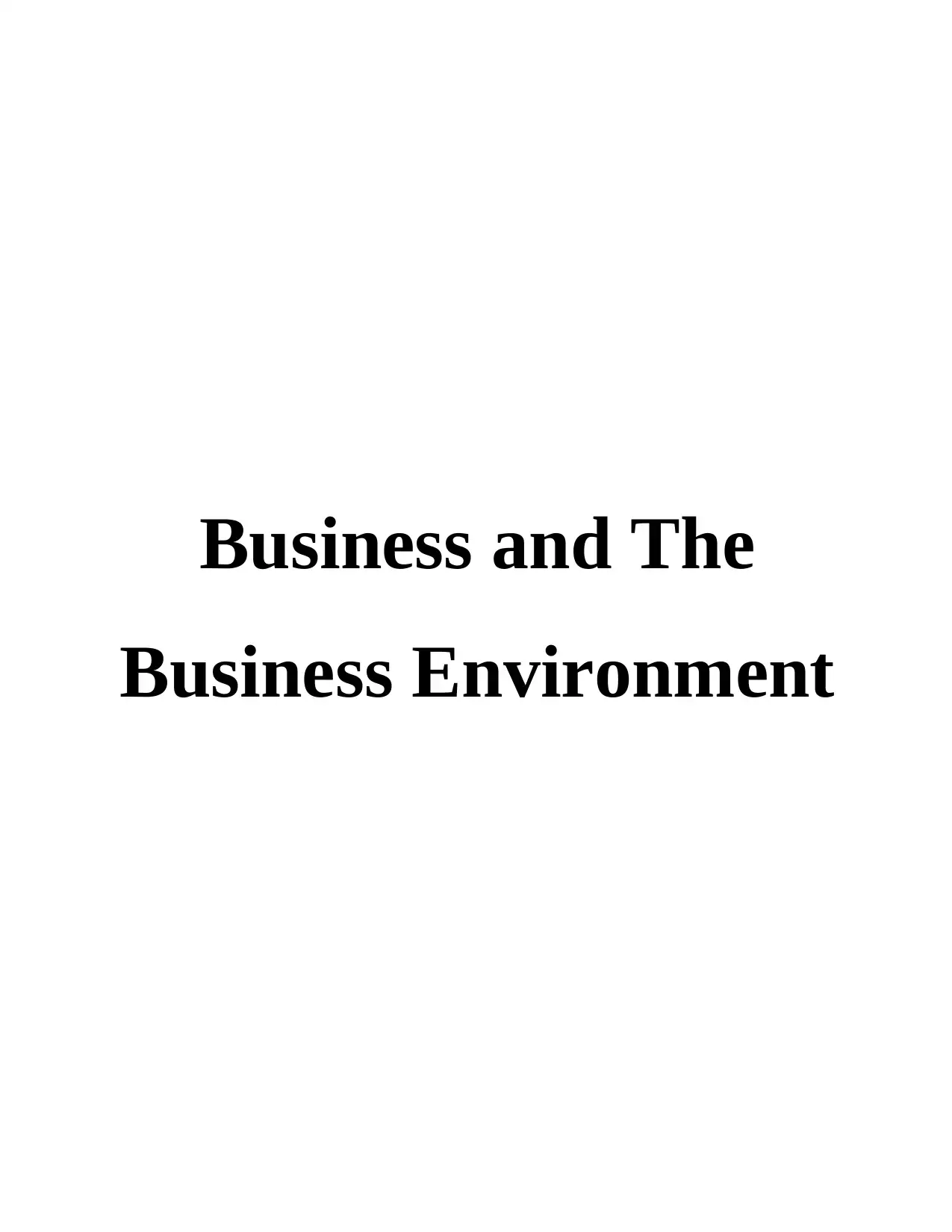
Business and The
Business Environment
Business Environment
Paraphrase This Document
Need a fresh take? Get an instant paraphrase of this document with our AI Paraphraser
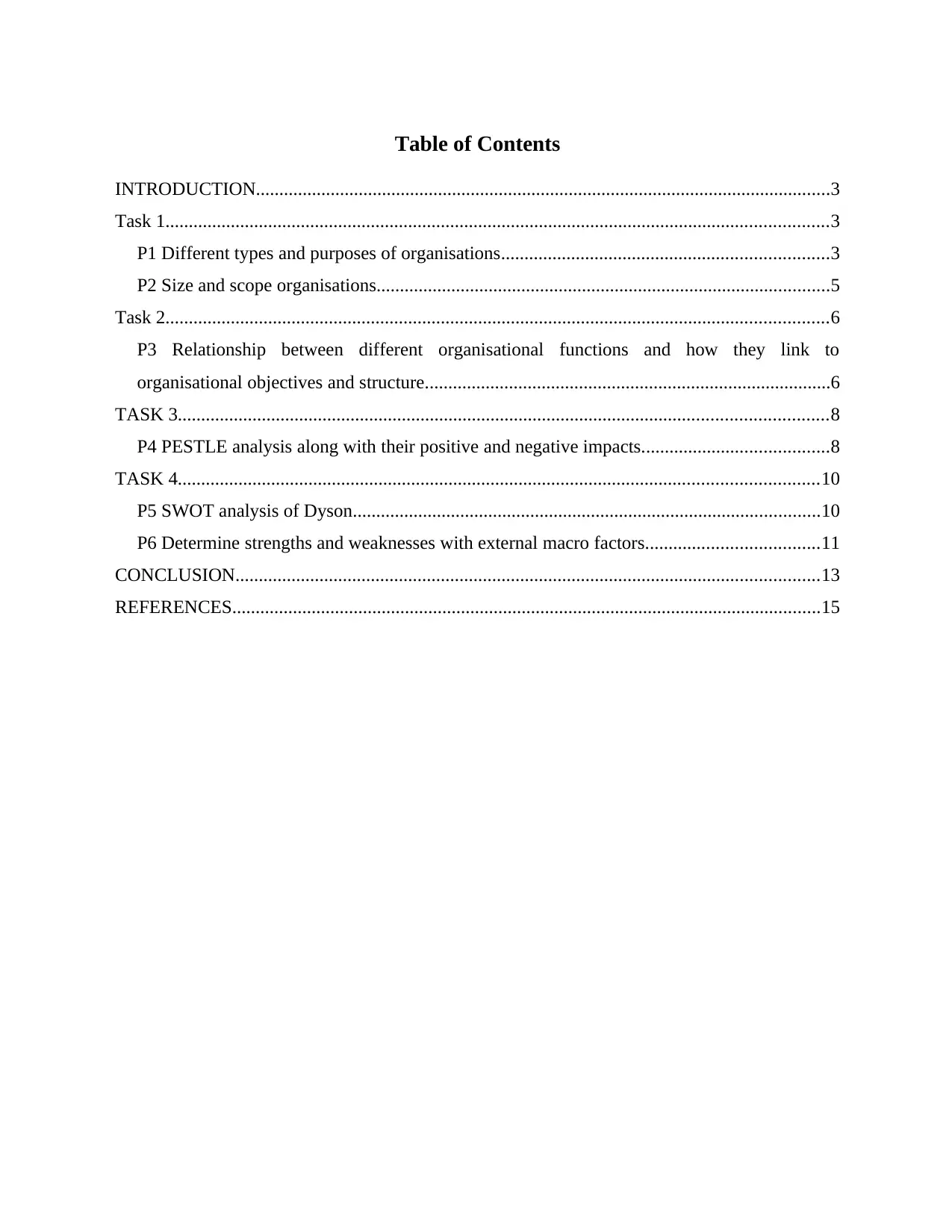
Table of Contents
INTRODUCTION...........................................................................................................................3
Task 1..............................................................................................................................................3
P1 Different types and purposes of organisations......................................................................3
P2 Size and scope organisations.................................................................................................5
Task 2..............................................................................................................................................6
P3 Relationship between different organisational functions and how they link to
organisational objectives and structure.......................................................................................6
TASK 3...........................................................................................................................................8
P4 PESTLE analysis along with their positive and negative impacts........................................8
TASK 4.........................................................................................................................................10
P5 SWOT analysis of Dyson....................................................................................................10
P6 Determine strengths and weaknesses with external macro factors.....................................11
CONCLUSION.............................................................................................................................13
REFERENCES..............................................................................................................................15
INTRODUCTION...........................................................................................................................3
Task 1..............................................................................................................................................3
P1 Different types and purposes of organisations......................................................................3
P2 Size and scope organisations.................................................................................................5
Task 2..............................................................................................................................................6
P3 Relationship between different organisational functions and how they link to
organisational objectives and structure.......................................................................................6
TASK 3...........................................................................................................................................8
P4 PESTLE analysis along with their positive and negative impacts........................................8
TASK 4.........................................................................................................................................10
P5 SWOT analysis of Dyson....................................................................................................10
P6 Determine strengths and weaknesses with external macro factors.....................................11
CONCLUSION.............................................................................................................................13
REFERENCES..............................................................................................................................15
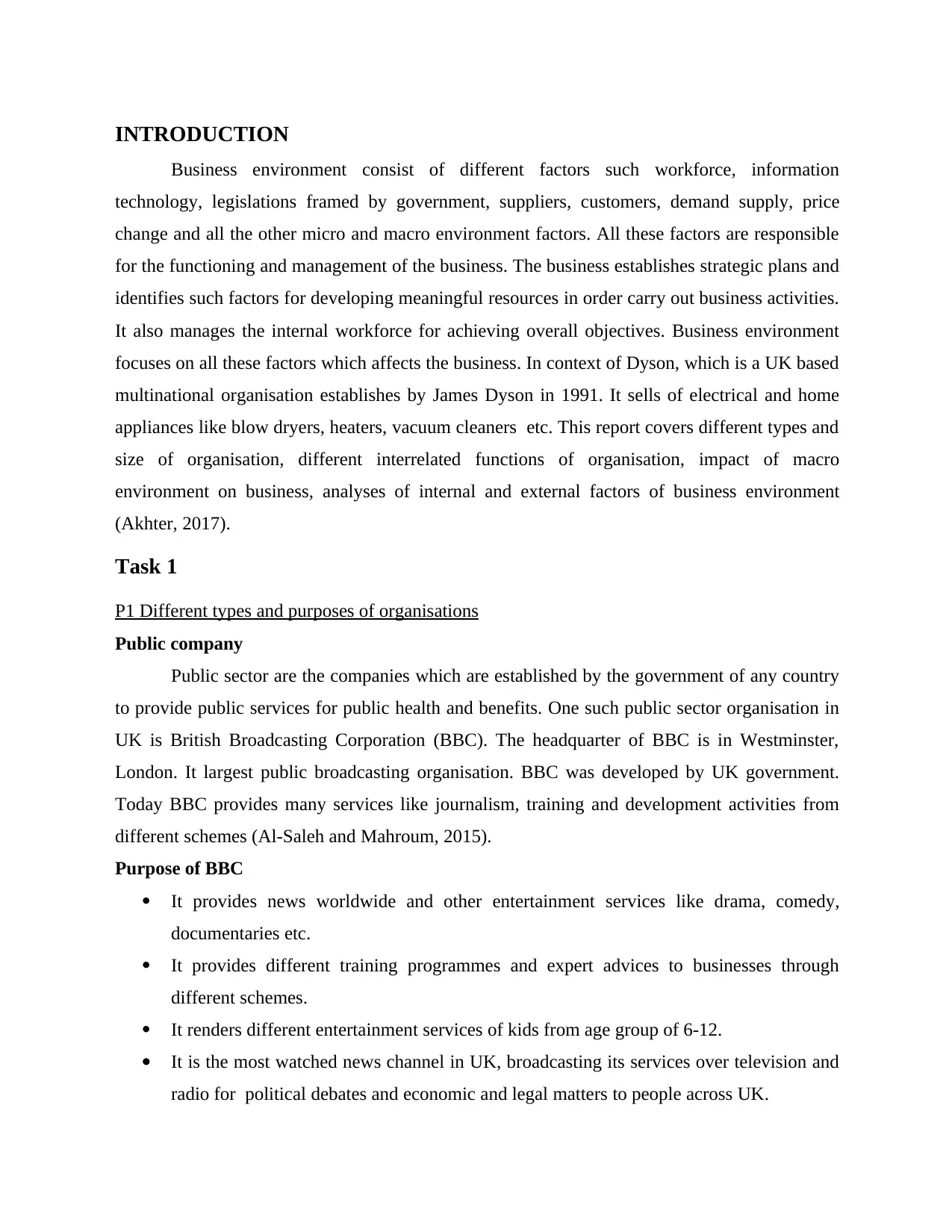
INTRODUCTION
Business environment consist of different factors such workforce, information
technology, legislations framed by government, suppliers, customers, demand supply, price
change and all the other micro and macro environment factors. All these factors are responsible
for the functioning and management of the business. The business establishes strategic plans and
identifies such factors for developing meaningful resources in order carry out business activities.
It also manages the internal workforce for achieving overall objectives. Business environment
focuses on all these factors which affects the business. In context of Dyson, which is a UK based
multinational organisation establishes by James Dyson in 1991. It sells of electrical and home
appliances like blow dryers, heaters, vacuum cleaners etc. This report covers different types and
size of organisation, different interrelated functions of organisation, impact of macro
environment on business, analyses of internal and external factors of business environment
(Akhter, 2017).
Task 1
P1 Different types and purposes of organisations
Public company
Public sector are the companies which are established by the government of any country
to provide public services for public health and benefits. One such public sector organisation in
UK is British Broadcasting Corporation (BBC). The headquarter of BBC is in Westminster,
London. It largest public broadcasting organisation. BBC was developed by UK government.
Today BBC provides many services like journalism, training and development activities from
different schemes (Al-Saleh and Mahroum, 2015).
Purpose of BBC
It provides news worldwide and other entertainment services like drama, comedy,
documentaries etc.
It provides different training programmes and expert advices to businesses through
different schemes.
It renders different entertainment services of kids from age group of 6-12.
It is the most watched news channel in UK, broadcasting its services over television and
radio for political debates and economic and legal matters to people across UK.
Business environment consist of different factors such workforce, information
technology, legislations framed by government, suppliers, customers, demand supply, price
change and all the other micro and macro environment factors. All these factors are responsible
for the functioning and management of the business. The business establishes strategic plans and
identifies such factors for developing meaningful resources in order carry out business activities.
It also manages the internal workforce for achieving overall objectives. Business environment
focuses on all these factors which affects the business. In context of Dyson, which is a UK based
multinational organisation establishes by James Dyson in 1991. It sells of electrical and home
appliances like blow dryers, heaters, vacuum cleaners etc. This report covers different types and
size of organisation, different interrelated functions of organisation, impact of macro
environment on business, analyses of internal and external factors of business environment
(Akhter, 2017).
Task 1
P1 Different types and purposes of organisations
Public company
Public sector are the companies which are established by the government of any country
to provide public services for public health and benefits. One such public sector organisation in
UK is British Broadcasting Corporation (BBC). The headquarter of BBC is in Westminster,
London. It largest public broadcasting organisation. BBC was developed by UK government.
Today BBC provides many services like journalism, training and development activities from
different schemes (Al-Saleh and Mahroum, 2015).
Purpose of BBC
It provides news worldwide and other entertainment services like drama, comedy,
documentaries etc.
It provides different training programmes and expert advices to businesses through
different schemes.
It renders different entertainment services of kids from age group of 6-12.
It is the most watched news channel in UK, broadcasting its services over television and
radio for political debates and economic and legal matters to people across UK.
⊘ This is a preview!⊘
Do you want full access?
Subscribe today to unlock all pages.

Trusted by 1+ million students worldwide
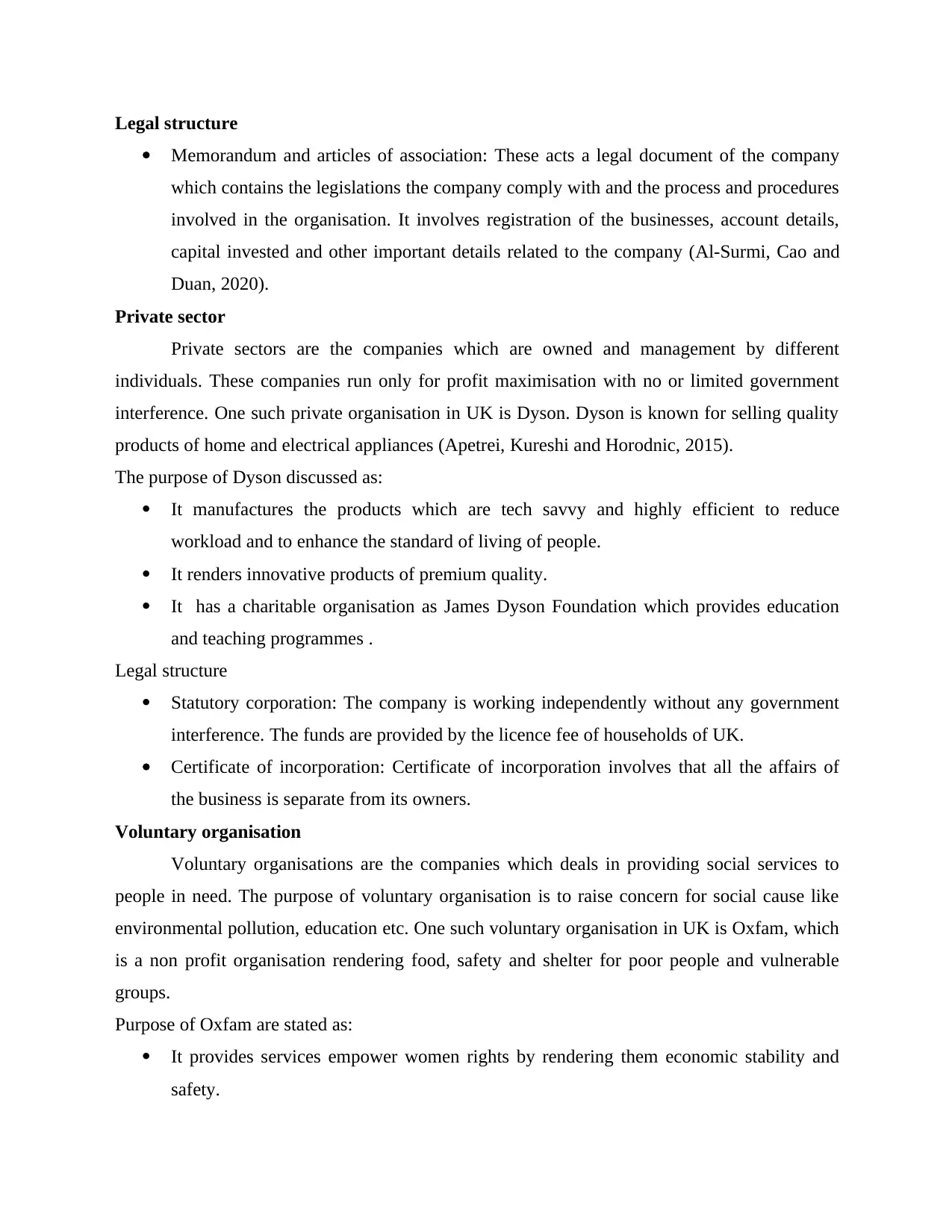
Legal structure
Memorandum and articles of association: These acts a legal document of the company
which contains the legislations the company comply with and the process and procedures
involved in the organisation. It involves registration of the businesses, account details,
capital invested and other important details related to the company (Al-Surmi, Cao and
Duan, 2020).
Private sector
Private sectors are the companies which are owned and management by different
individuals. These companies run only for profit maximisation with no or limited government
interference. One such private organisation in UK is Dyson. Dyson is known for selling quality
products of home and electrical appliances (Apetrei, Kureshi and Horodnic, 2015).
The purpose of Dyson discussed as:
It manufactures the products which are tech savvy and highly efficient to reduce
workload and to enhance the standard of living of people.
It renders innovative products of premium quality.
It has a charitable organisation as James Dyson Foundation which provides education
and teaching programmes .
Legal structure
Statutory corporation: The company is working independently without any government
interference. The funds are provided by the licence fee of households of UK.
Certificate of incorporation: Certificate of incorporation involves that all the affairs of
the business is separate from its owners.
Voluntary organisation
Voluntary organisations are the companies which deals in providing social services to
people in need. The purpose of voluntary organisation is to raise concern for social cause like
environmental pollution, education etc. One such voluntary organisation in UK is Oxfam, which
is a non profit organisation rendering food, safety and shelter for poor people and vulnerable
groups.
Purpose of Oxfam are stated as:
It provides services empower women rights by rendering them economic stability and
safety.
Memorandum and articles of association: These acts a legal document of the company
which contains the legislations the company comply with and the process and procedures
involved in the organisation. It involves registration of the businesses, account details,
capital invested and other important details related to the company (Al-Surmi, Cao and
Duan, 2020).
Private sector
Private sectors are the companies which are owned and management by different
individuals. These companies run only for profit maximisation with no or limited government
interference. One such private organisation in UK is Dyson. Dyson is known for selling quality
products of home and electrical appliances (Apetrei, Kureshi and Horodnic, 2015).
The purpose of Dyson discussed as:
It manufactures the products which are tech savvy and highly efficient to reduce
workload and to enhance the standard of living of people.
It renders innovative products of premium quality.
It has a charitable organisation as James Dyson Foundation which provides education
and teaching programmes .
Legal structure
Statutory corporation: The company is working independently without any government
interference. The funds are provided by the licence fee of households of UK.
Certificate of incorporation: Certificate of incorporation involves that all the affairs of
the business is separate from its owners.
Voluntary organisation
Voluntary organisations are the companies which deals in providing social services to
people in need. The purpose of voluntary organisation is to raise concern for social cause like
environmental pollution, education etc. One such voluntary organisation in UK is Oxfam, which
is a non profit organisation rendering food, safety and shelter for poor people and vulnerable
groups.
Purpose of Oxfam are stated as:
It provides services empower women rights by rendering them economic stability and
safety.
Paraphrase This Document
Need a fresh take? Get an instant paraphrase of this document with our AI Paraphraser
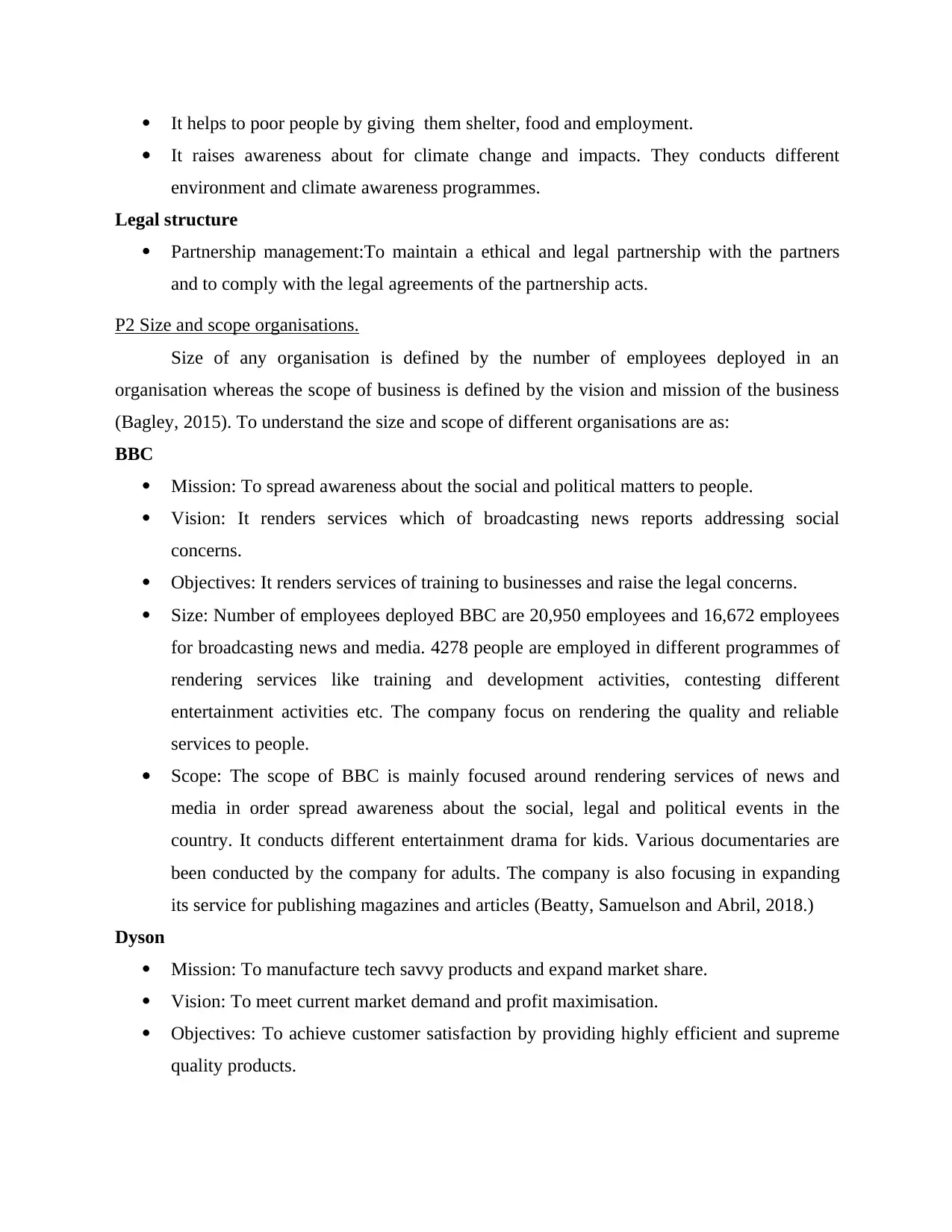
It helps to poor people by giving them shelter, food and employment.
It raises awareness about for climate change and impacts. They conducts different
environment and climate awareness programmes.
Legal structure
Partnership management:To maintain a ethical and legal partnership with the partners
and to comply with the legal agreements of the partnership acts.
P2 Size and scope organisations.
Size of any organisation is defined by the number of employees deployed in an
organisation whereas the scope of business is defined by the vision and mission of the business
(Bagley, 2015). To understand the size and scope of different organisations are as:
BBC
Mission: To spread awareness about the social and political matters to people.
Vision: It renders services which of broadcasting news reports addressing social
concerns.
Objectives: It renders services of training to businesses and raise the legal concerns.
Size: Number of employees deployed BBC are 20,950 employees and 16,672 employees
for broadcasting news and media. 4278 people are employed in different programmes of
rendering services like training and development activities, contesting different
entertainment activities etc. The company focus on rendering the quality and reliable
services to people.
Scope: The scope of BBC is mainly focused around rendering services of news and
media in order spread awareness about the social, legal and political events in the
country. It conducts different entertainment drama for kids. Various documentaries are
been conducted by the company for adults. The company is also focusing in expanding
its service for publishing magazines and articles (Beatty, Samuelson and Abril, 2018.)
Dyson
Mission: To manufacture tech savvy products and expand market share.
Vision: To meet current market demand and profit maximisation.
Objectives: To achieve customer satisfaction by providing highly efficient and supreme
quality products.
It raises awareness about for climate change and impacts. They conducts different
environment and climate awareness programmes.
Legal structure
Partnership management:To maintain a ethical and legal partnership with the partners
and to comply with the legal agreements of the partnership acts.
P2 Size and scope organisations.
Size of any organisation is defined by the number of employees deployed in an
organisation whereas the scope of business is defined by the vision and mission of the business
(Bagley, 2015). To understand the size and scope of different organisations are as:
BBC
Mission: To spread awareness about the social and political matters to people.
Vision: It renders services which of broadcasting news reports addressing social
concerns.
Objectives: It renders services of training to businesses and raise the legal concerns.
Size: Number of employees deployed BBC are 20,950 employees and 16,672 employees
for broadcasting news and media. 4278 people are employed in different programmes of
rendering services like training and development activities, contesting different
entertainment activities etc. The company focus on rendering the quality and reliable
services to people.
Scope: The scope of BBC is mainly focused around rendering services of news and
media in order spread awareness about the social, legal and political events in the
country. It conducts different entertainment drama for kids. Various documentaries are
been conducted by the company for adults. The company is also focusing in expanding
its service for publishing magazines and articles (Beatty, Samuelson and Abril, 2018.)
Dyson
Mission: To manufacture tech savvy products and expand market share.
Vision: To meet current market demand and profit maximisation.
Objectives: To achieve customer satisfaction by providing highly efficient and supreme
quality products.
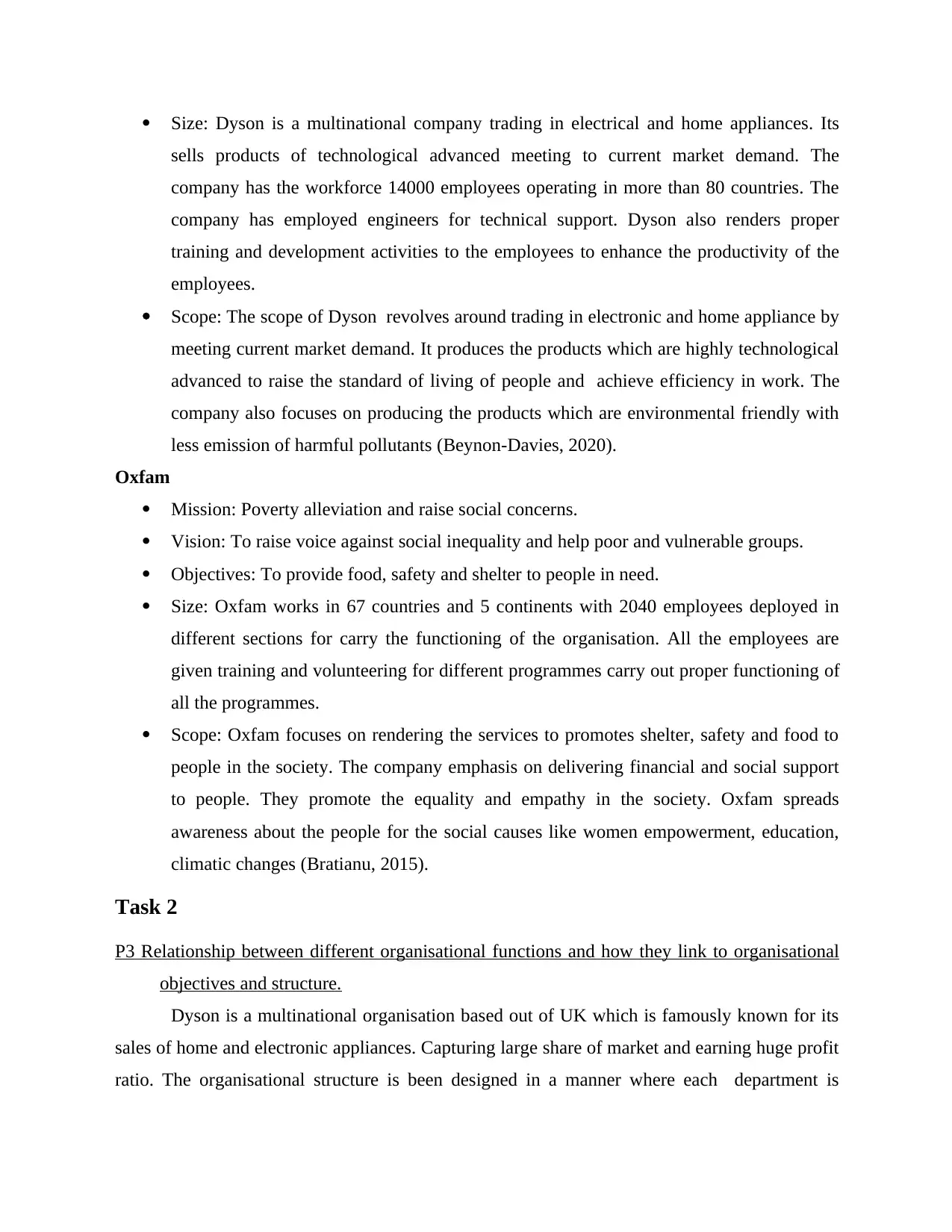
Size: Dyson is a multinational company trading in electrical and home appliances. Its
sells products of technological advanced meeting to current market demand. The
company has the workforce 14000 employees operating in more than 80 countries. The
company has employed engineers for technical support. Dyson also renders proper
training and development activities to the employees to enhance the productivity of the
employees.
Scope: The scope of Dyson revolves around trading in electronic and home appliance by
meeting current market demand. It produces the products which are highly technological
advanced to raise the standard of living of people and achieve efficiency in work. The
company also focuses on producing the products which are environmental friendly with
less emission of harmful pollutants (Beynon-Davies, 2020).
Oxfam
Mission: Poverty alleviation and raise social concerns.
Vision: To raise voice against social inequality and help poor and vulnerable groups.
Objectives: To provide food, safety and shelter to people in need.
Size: Oxfam works in 67 countries and 5 continents with 2040 employees deployed in
different sections for carry the functioning of the organisation. All the employees are
given training and volunteering for different programmes carry out proper functioning of
all the programmes.
Scope: Oxfam focuses on rendering the services to promotes shelter, safety and food to
people in the society. The company emphasis on delivering financial and social support
to people. They promote the equality and empathy in the society. Oxfam spreads
awareness about the people for the social causes like women empowerment, education,
climatic changes (Bratianu, 2015).
Task 2
P3 Relationship between different organisational functions and how they link to organisational
objectives and structure.
Dyson is a multinational organisation based out of UK which is famously known for its
sales of home and electronic appliances. Capturing large share of market and earning huge profit
ratio. The organisational structure is been designed in a manner where each department is
sells products of technological advanced meeting to current market demand. The
company has the workforce 14000 employees operating in more than 80 countries. The
company has employed engineers for technical support. Dyson also renders proper
training and development activities to the employees to enhance the productivity of the
employees.
Scope: The scope of Dyson revolves around trading in electronic and home appliance by
meeting current market demand. It produces the products which are highly technological
advanced to raise the standard of living of people and achieve efficiency in work. The
company also focuses on producing the products which are environmental friendly with
less emission of harmful pollutants (Beynon-Davies, 2020).
Oxfam
Mission: Poverty alleviation and raise social concerns.
Vision: To raise voice against social inequality and help poor and vulnerable groups.
Objectives: To provide food, safety and shelter to people in need.
Size: Oxfam works in 67 countries and 5 continents with 2040 employees deployed in
different sections for carry the functioning of the organisation. All the employees are
given training and volunteering for different programmes carry out proper functioning of
all the programmes.
Scope: Oxfam focuses on rendering the services to promotes shelter, safety and food to
people in the society. The company emphasis on delivering financial and social support
to people. They promote the equality and empathy in the society. Oxfam spreads
awareness about the people for the social causes like women empowerment, education,
climatic changes (Bratianu, 2015).
Task 2
P3 Relationship between different organisational functions and how they link to organisational
objectives and structure.
Dyson is a multinational organisation based out of UK which is famously known for its
sales of home and electronic appliances. Capturing large share of market and earning huge profit
ratio. The organisational structure is been designed in a manner where each department is
⊘ This is a preview!⊘
Do you want full access?
Subscribe today to unlock all pages.

Trusted by 1+ million students worldwide
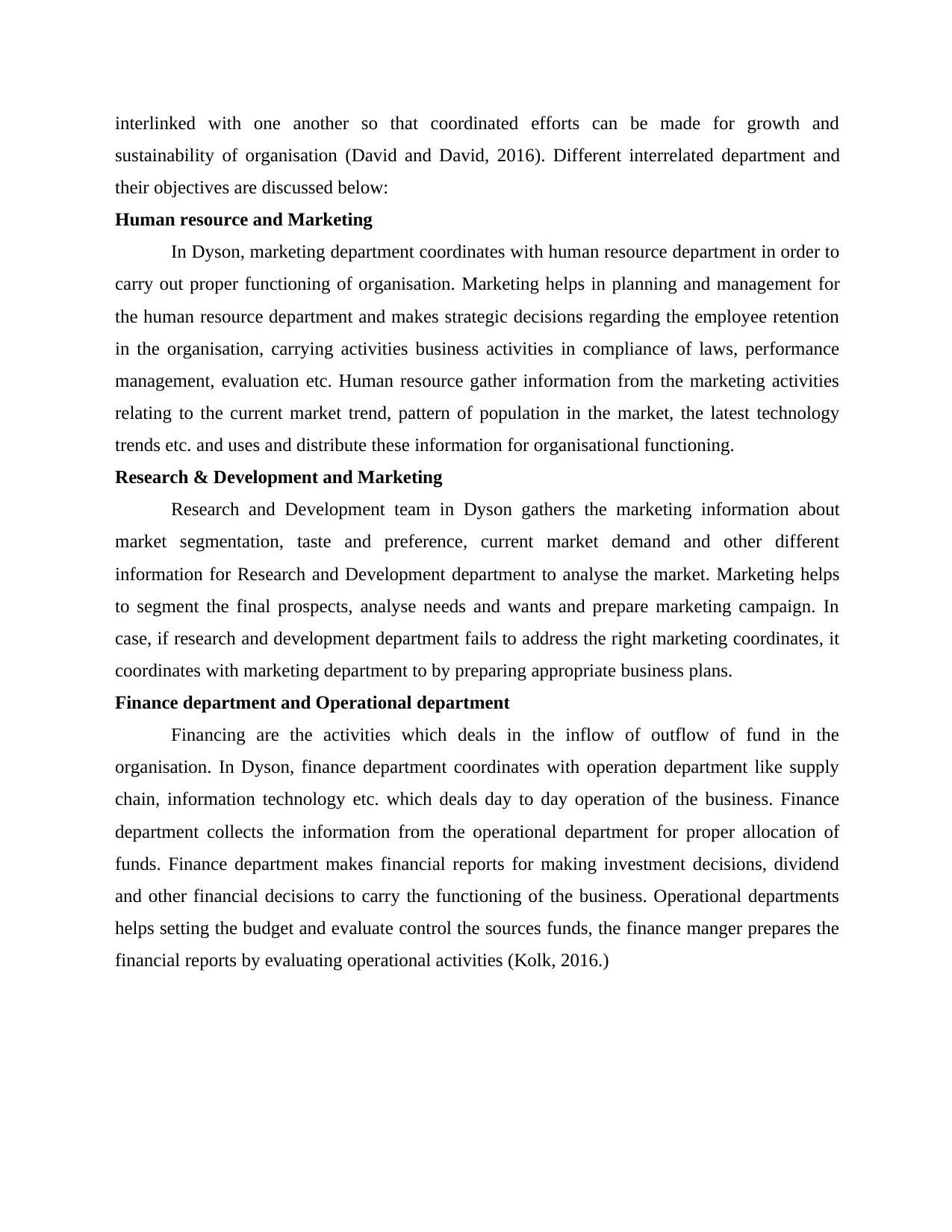
interlinked with one another so that coordinated efforts can be made for growth and
sustainability of organisation (David and David, 2016). Different interrelated department and
their objectives are discussed below:
Human resource and Marketing
In Dyson, marketing department coordinates with human resource department in order to
carry out proper functioning of organisation. Marketing helps in planning and management for
the human resource department and makes strategic decisions regarding the employee retention
in the organisation, carrying activities business activities in compliance of laws, performance
management, evaluation etc. Human resource gather information from the marketing activities
relating to the current market trend, pattern of population in the market, the latest technology
trends etc. and uses and distribute these information for organisational functioning.
Research & Development and Marketing
Research and Development team in Dyson gathers the marketing information about
market segmentation, taste and preference, current market demand and other different
information for Research and Development department to analyse the market. Marketing helps
to segment the final prospects, analyse needs and wants and prepare marketing campaign. In
case, if research and development department fails to address the right marketing coordinates, it
coordinates with marketing department to by preparing appropriate business plans.
Finance department and Operational department
Financing are the activities which deals in the inflow of outflow of fund in the
organisation. In Dyson, finance department coordinates with operation department like supply
chain, information technology etc. which deals day to day operation of the business. Finance
department collects the information from the operational department for proper allocation of
funds. Finance department makes financial reports for making investment decisions, dividend
and other financial decisions to carry the functioning of the business. Operational departments
helps setting the budget and evaluate control the sources funds, the finance manger prepares the
financial reports by evaluating operational activities (Kolk, 2016.)
sustainability of organisation (David and David, 2016). Different interrelated department and
their objectives are discussed below:
Human resource and Marketing
In Dyson, marketing department coordinates with human resource department in order to
carry out proper functioning of organisation. Marketing helps in planning and management for
the human resource department and makes strategic decisions regarding the employee retention
in the organisation, carrying activities business activities in compliance of laws, performance
management, evaluation etc. Human resource gather information from the marketing activities
relating to the current market trend, pattern of population in the market, the latest technology
trends etc. and uses and distribute these information for organisational functioning.
Research & Development and Marketing
Research and Development team in Dyson gathers the marketing information about
market segmentation, taste and preference, current market demand and other different
information for Research and Development department to analyse the market. Marketing helps
to segment the final prospects, analyse needs and wants and prepare marketing campaign. In
case, if research and development department fails to address the right marketing coordinates, it
coordinates with marketing department to by preparing appropriate business plans.
Finance department and Operational department
Financing are the activities which deals in the inflow of outflow of fund in the
organisation. In Dyson, finance department coordinates with operation department like supply
chain, information technology etc. which deals day to day operation of the business. Finance
department collects the information from the operational department for proper allocation of
funds. Finance department makes financial reports for making investment decisions, dividend
and other financial decisions to carry the functioning of the business. Operational departments
helps setting the budget and evaluate control the sources funds, the finance manger prepares the
financial reports by evaluating operational activities (Kolk, 2016.)
Paraphrase This Document
Need a fresh take? Get an instant paraphrase of this document with our AI Paraphraser
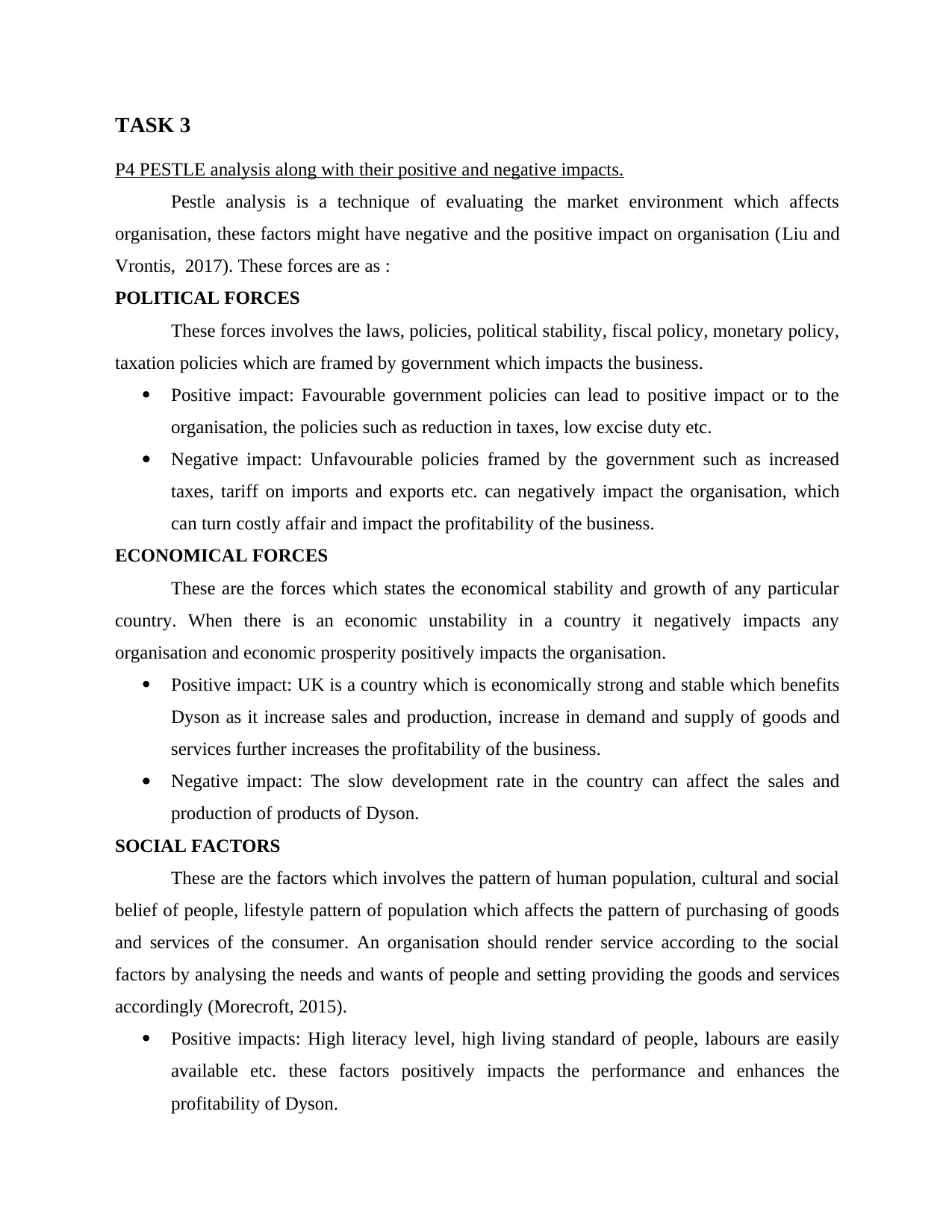
TASK 3
P4 PESTLE analysis along with their positive and negative impacts.
Pestle analysis is a technique of evaluating the market environment which affects
organisation, these factors might have negative and the positive impact on organisation (Liu and
Vrontis, 2017). These forces are as :
POLITICAL FORCES
These forces involves the laws, policies, political stability, fiscal policy, monetary policy,
taxation policies which are framed by government which impacts the business.
Positive impact: Favourable government policies can lead to positive impact or to the
organisation, the policies such as reduction in taxes, low excise duty etc.
Negative impact: Unfavourable policies framed by the government such as increased
taxes, tariff on imports and exports etc. can negatively impact the organisation, which
can turn costly affair and impact the profitability of the business.
ECONOMICAL FORCES
These are the forces which states the economical stability and growth of any particular
country. When there is an economic unstability in a country it negatively impacts any
organisation and economic prosperity positively impacts the organisation.
Positive impact: UK is a country which is economically strong and stable which benefits
Dyson as it increase sales and production, increase in demand and supply of goods and
services further increases the profitability of the business.
Negative impact: The slow development rate in the country can affect the sales and
production of products of Dyson.
SOCIAL FACTORS
These are the factors which involves the pattern of human population, cultural and social
belief of people, lifestyle pattern of population which affects the pattern of purchasing of goods
and services of the consumer. An organisation should render service according to the social
factors by analysing the needs and wants of people and setting providing the goods and services
accordingly (Morecroft, 2015).
Positive impacts: High literacy level, high living standard of people, labours are easily
available etc. these factors positively impacts the performance and enhances the
profitability of Dyson.
P4 PESTLE analysis along with their positive and negative impacts.
Pestle analysis is a technique of evaluating the market environment which affects
organisation, these factors might have negative and the positive impact on organisation (Liu and
Vrontis, 2017). These forces are as :
POLITICAL FORCES
These forces involves the laws, policies, political stability, fiscal policy, monetary policy,
taxation policies which are framed by government which impacts the business.
Positive impact: Favourable government policies can lead to positive impact or to the
organisation, the policies such as reduction in taxes, low excise duty etc.
Negative impact: Unfavourable policies framed by the government such as increased
taxes, tariff on imports and exports etc. can negatively impact the organisation, which
can turn costly affair and impact the profitability of the business.
ECONOMICAL FORCES
These are the forces which states the economical stability and growth of any particular
country. When there is an economic unstability in a country it negatively impacts any
organisation and economic prosperity positively impacts the organisation.
Positive impact: UK is a country which is economically strong and stable which benefits
Dyson as it increase sales and production, increase in demand and supply of goods and
services further increases the profitability of the business.
Negative impact: The slow development rate in the country can affect the sales and
production of products of Dyson.
SOCIAL FACTORS
These are the factors which involves the pattern of human population, cultural and social
belief of people, lifestyle pattern of population which affects the pattern of purchasing of goods
and services of the consumer. An organisation should render service according to the social
factors by analysing the needs and wants of people and setting providing the goods and services
accordingly (Morecroft, 2015).
Positive impacts: High literacy level, high living standard of people, labours are easily
available etc. these factors positively impacts the performance and enhances the
profitability of Dyson.
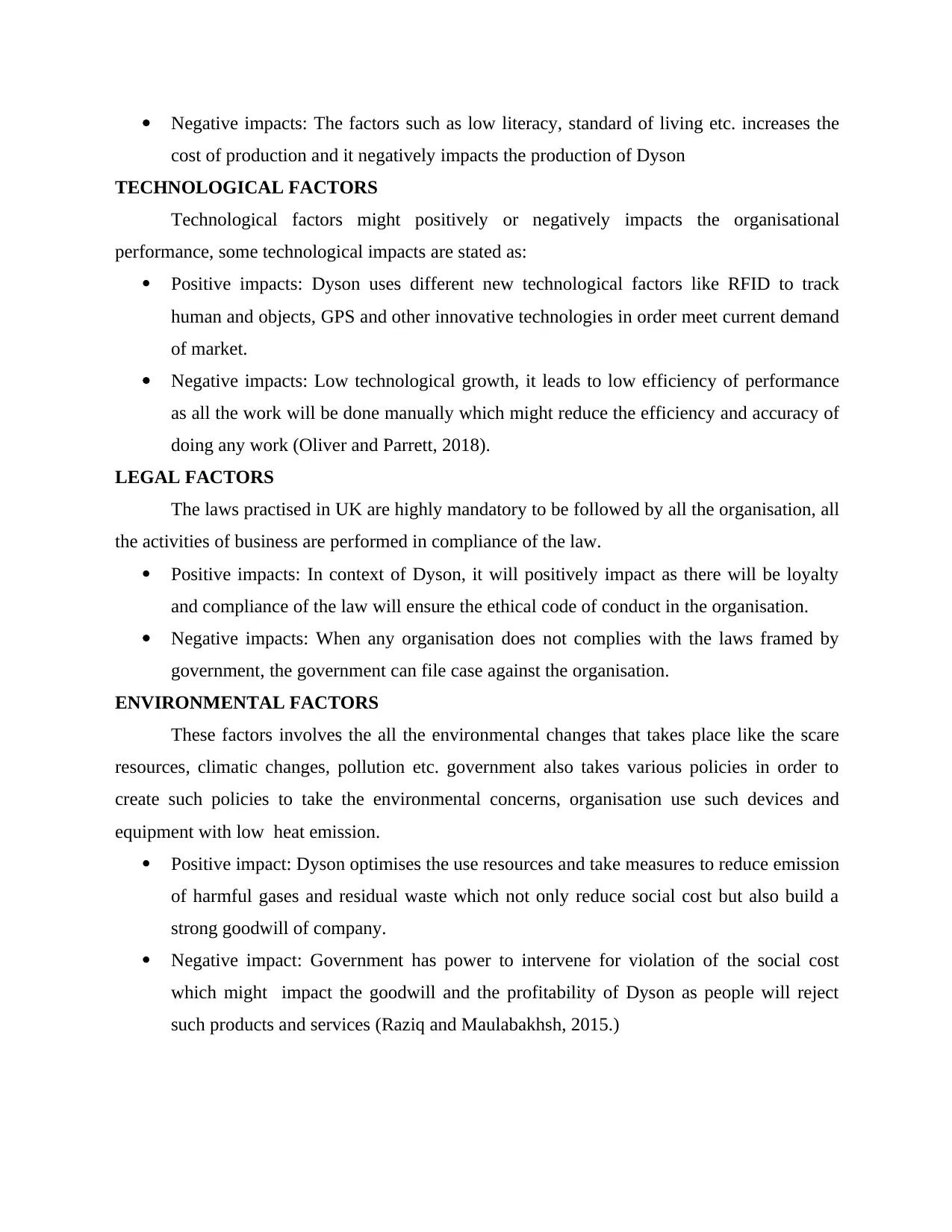
Negative impacts: The factors such as low literacy, standard of living etc. increases the
cost of production and it negatively impacts the production of Dyson
TECHNOLOGICAL FACTORS
Technological factors might positively or negatively impacts the organisational
performance, some technological impacts are stated as:
Positive impacts: Dyson uses different new technological factors like RFID to track
human and objects, GPS and other innovative technologies in order meet current demand
of market.
Negative impacts: Low technological growth, it leads to low efficiency of performance
as all the work will be done manually which might reduce the efficiency and accuracy of
doing any work (Oliver and Parrett, 2018).
LEGAL FACTORS
The laws practised in UK are highly mandatory to be followed by all the organisation, all
the activities of business are performed in compliance of the law.
Positive impacts: In context of Dyson, it will positively impact as there will be loyalty
and compliance of the law will ensure the ethical code of conduct in the organisation.
Negative impacts: When any organisation does not complies with the laws framed by
government, the government can file case against the organisation.
ENVIRONMENTAL FACTORS
These factors involves the all the environmental changes that takes place like the scare
resources, climatic changes, pollution etc. government also takes various policies in order to
create such policies to take the environmental concerns, organisation use such devices and
equipment with low heat emission.
Positive impact: Dyson optimises the use resources and take measures to reduce emission
of harmful gases and residual waste which not only reduce social cost but also build a
strong goodwill of company.
Negative impact: Government has power to intervene for violation of the social cost
which might impact the goodwill and the profitability of Dyson as people will reject
such products and services (Raziq and Maulabakhsh, 2015.)
cost of production and it negatively impacts the production of Dyson
TECHNOLOGICAL FACTORS
Technological factors might positively or negatively impacts the organisational
performance, some technological impacts are stated as:
Positive impacts: Dyson uses different new technological factors like RFID to track
human and objects, GPS and other innovative technologies in order meet current demand
of market.
Negative impacts: Low technological growth, it leads to low efficiency of performance
as all the work will be done manually which might reduce the efficiency and accuracy of
doing any work (Oliver and Parrett, 2018).
LEGAL FACTORS
The laws practised in UK are highly mandatory to be followed by all the organisation, all
the activities of business are performed in compliance of the law.
Positive impacts: In context of Dyson, it will positively impact as there will be loyalty
and compliance of the law will ensure the ethical code of conduct in the organisation.
Negative impacts: When any organisation does not complies with the laws framed by
government, the government can file case against the organisation.
ENVIRONMENTAL FACTORS
These factors involves the all the environmental changes that takes place like the scare
resources, climatic changes, pollution etc. government also takes various policies in order to
create such policies to take the environmental concerns, organisation use such devices and
equipment with low heat emission.
Positive impact: Dyson optimises the use resources and take measures to reduce emission
of harmful gases and residual waste which not only reduce social cost but also build a
strong goodwill of company.
Negative impact: Government has power to intervene for violation of the social cost
which might impact the goodwill and the profitability of Dyson as people will reject
such products and services (Raziq and Maulabakhsh, 2015.)
⊘ This is a preview!⊘
Do you want full access?
Subscribe today to unlock all pages.

Trusted by 1+ million students worldwide
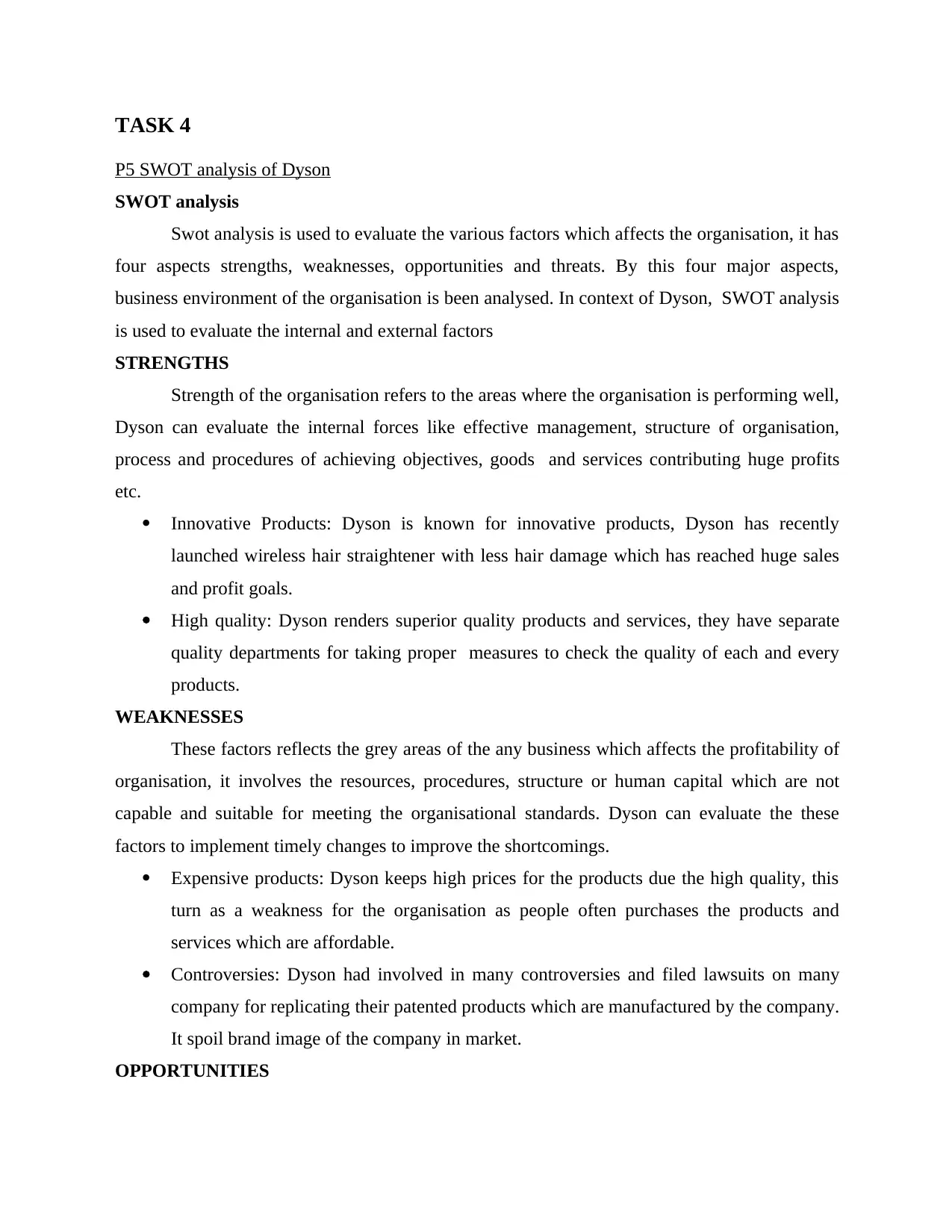
TASK 4
P5 SWOT analysis of Dyson
SWOT analysis
Swot analysis is used to evaluate the various factors which affects the organisation, it has
four aspects strengths, weaknesses, opportunities and threats. By this four major aspects,
business environment of the organisation is been analysed. In context of Dyson, SWOT analysis
is used to evaluate the internal and external factors
STRENGTHS
Strength of the organisation refers to the areas where the organisation is performing well,
Dyson can evaluate the internal forces like effective management, structure of organisation,
process and procedures of achieving objectives, goods and services contributing huge profits
etc.
Innovative Products: Dyson is known for innovative products, Dyson has recently
launched wireless hair straightener with less hair damage which has reached huge sales
and profit goals.
High quality: Dyson renders superior quality products and services, they have separate
quality departments for taking proper measures to check the quality of each and every
products.
WEAKNESSES
These factors reflects the grey areas of the any business which affects the profitability of
organisation, it involves the resources, procedures, structure or human capital which are not
capable and suitable for meeting the organisational standards. Dyson can evaluate the these
factors to implement timely changes to improve the shortcomings.
Expensive products: Dyson keeps high prices for the products due the high quality, this
turn as a weakness for the organisation as people often purchases the products and
services which are affordable.
Controversies: Dyson had involved in many controversies and filed lawsuits on many
company for replicating their patented products which are manufactured by the company.
It spoil brand image of the company in market.
OPPORTUNITIES
P5 SWOT analysis of Dyson
SWOT analysis
Swot analysis is used to evaluate the various factors which affects the organisation, it has
four aspects strengths, weaknesses, opportunities and threats. By this four major aspects,
business environment of the organisation is been analysed. In context of Dyson, SWOT analysis
is used to evaluate the internal and external factors
STRENGTHS
Strength of the organisation refers to the areas where the organisation is performing well,
Dyson can evaluate the internal forces like effective management, structure of organisation,
process and procedures of achieving objectives, goods and services contributing huge profits
etc.
Innovative Products: Dyson is known for innovative products, Dyson has recently
launched wireless hair straightener with less hair damage which has reached huge sales
and profit goals.
High quality: Dyson renders superior quality products and services, they have separate
quality departments for taking proper measures to check the quality of each and every
products.
WEAKNESSES
These factors reflects the grey areas of the any business which affects the profitability of
organisation, it involves the resources, procedures, structure or human capital which are not
capable and suitable for meeting the organisational standards. Dyson can evaluate the these
factors to implement timely changes to improve the shortcomings.
Expensive products: Dyson keeps high prices for the products due the high quality, this
turn as a weakness for the organisation as people often purchases the products and
services which are affordable.
Controversies: Dyson had involved in many controversies and filed lawsuits on many
company for replicating their patented products which are manufactured by the company.
It spoil brand image of the company in market.
OPPORTUNITIES
Paraphrase This Document
Need a fresh take? Get an instant paraphrase of this document with our AI Paraphraser
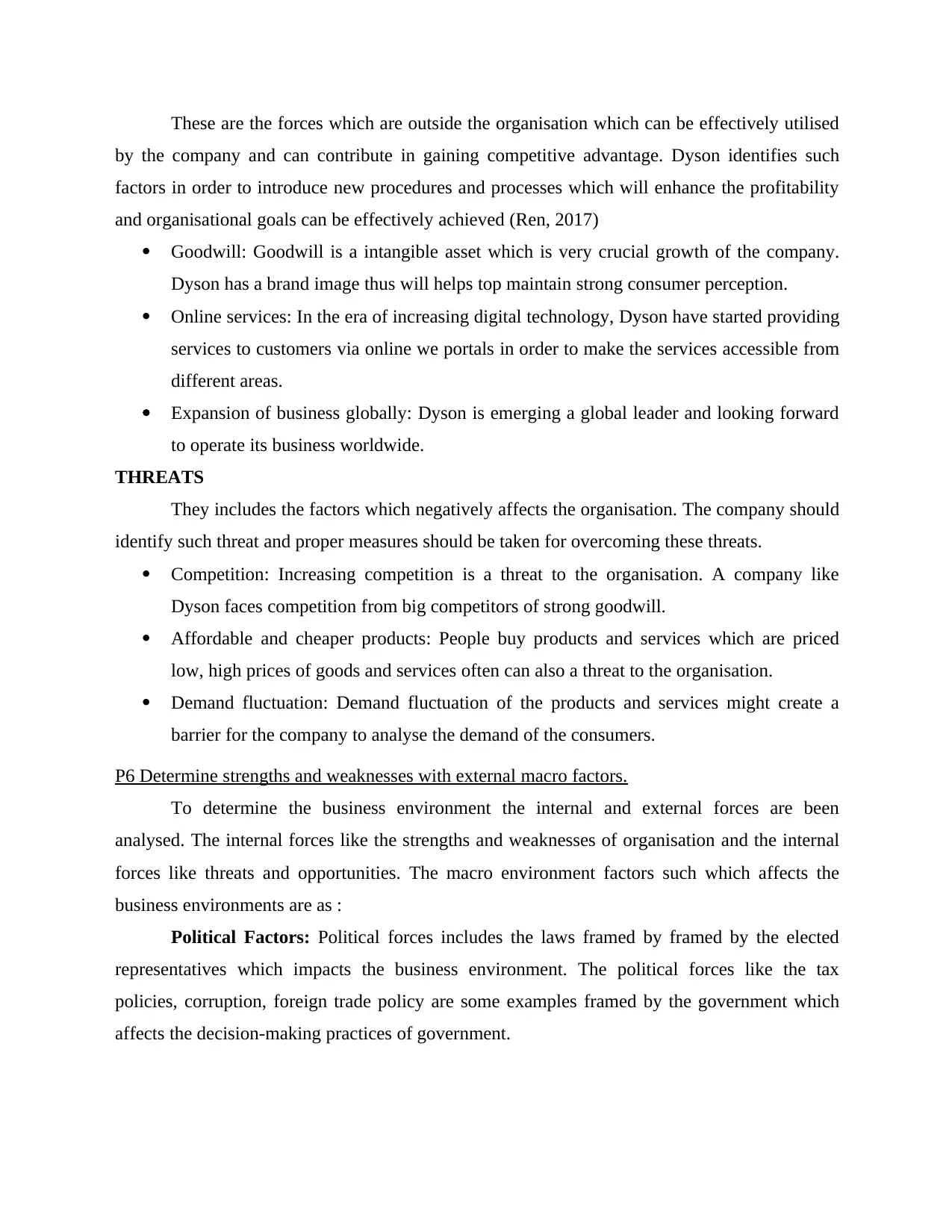
These are the forces which are outside the organisation which can be effectively utilised
by the company and can contribute in gaining competitive advantage. Dyson identifies such
factors in order to introduce new procedures and processes which will enhance the profitability
and organisational goals can be effectively achieved (Ren, 2017)
Goodwill: Goodwill is a intangible asset which is very crucial growth of the company.
Dyson has a brand image thus will helps top maintain strong consumer perception.
Online services: In the era of increasing digital technology, Dyson have started providing
services to customers via online we portals in order to make the services accessible from
different areas.
Expansion of business globally: Dyson is emerging a global leader and looking forward
to operate its business worldwide.
THREATS
They includes the factors which negatively affects the organisation. The company should
identify such threat and proper measures should be taken for overcoming these threats.
Competition: Increasing competition is a threat to the organisation. A company like
Dyson faces competition from big competitors of strong goodwill.
Affordable and cheaper products: People buy products and services which are priced
low, high prices of goods and services often can also a threat to the organisation.
Demand fluctuation: Demand fluctuation of the products and services might create a
barrier for the company to analyse the demand of the consumers.
P6 Determine strengths and weaknesses with external macro factors.
To determine the business environment the internal and external forces are been
analysed. The internal forces like the strengths and weaknesses of organisation and the internal
forces like threats and opportunities. The macro environment factors such which affects the
business environments are as :
Political Factors: Political forces includes the laws framed by framed by the elected
representatives which impacts the business environment. The political forces like the tax
policies, corruption, foreign trade policy are some examples framed by the government which
affects the decision-making practices of government.
by the company and can contribute in gaining competitive advantage. Dyson identifies such
factors in order to introduce new procedures and processes which will enhance the profitability
and organisational goals can be effectively achieved (Ren, 2017)
Goodwill: Goodwill is a intangible asset which is very crucial growth of the company.
Dyson has a brand image thus will helps top maintain strong consumer perception.
Online services: In the era of increasing digital technology, Dyson have started providing
services to customers via online we portals in order to make the services accessible from
different areas.
Expansion of business globally: Dyson is emerging a global leader and looking forward
to operate its business worldwide.
THREATS
They includes the factors which negatively affects the organisation. The company should
identify such threat and proper measures should be taken for overcoming these threats.
Competition: Increasing competition is a threat to the organisation. A company like
Dyson faces competition from big competitors of strong goodwill.
Affordable and cheaper products: People buy products and services which are priced
low, high prices of goods and services often can also a threat to the organisation.
Demand fluctuation: Demand fluctuation of the products and services might create a
barrier for the company to analyse the demand of the consumers.
P6 Determine strengths and weaknesses with external macro factors.
To determine the business environment the internal and external forces are been
analysed. The internal forces like the strengths and weaknesses of organisation and the internal
forces like threats and opportunities. The macro environment factors such which affects the
business environments are as :
Political Factors: Political forces includes the laws framed by framed by the elected
representatives which impacts the business environment. The political forces like the tax
policies, corruption, foreign trade policy are some examples framed by the government which
affects the decision-making practices of government.
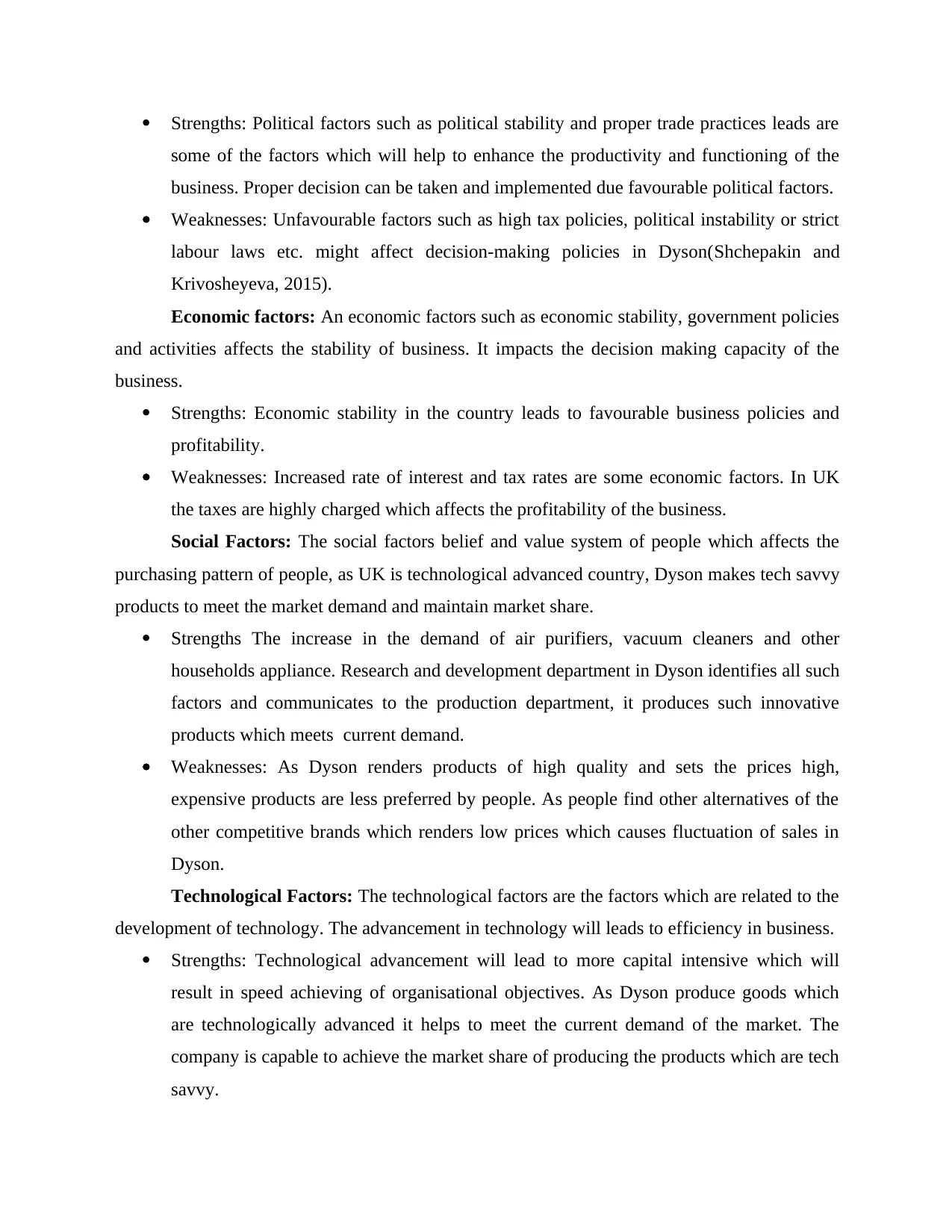
Strengths: Political factors such as political stability and proper trade practices leads are
some of the factors which will help to enhance the productivity and functioning of the
business. Proper decision can be taken and implemented due favourable political factors.
Weaknesses: Unfavourable factors such as high tax policies, political instability or strict
labour laws etc. might affect decision-making policies in Dyson(Shchepakin and
Krivosheyeva, 2015).
Economic factors: An economic factors such as economic stability, government policies
and activities affects the stability of business. It impacts the decision making capacity of the
business.
Strengths: Economic stability in the country leads to favourable business policies and
profitability.
Weaknesses: Increased rate of interest and tax rates are some economic factors. In UK
the taxes are highly charged which affects the profitability of the business.
Social Factors: The social factors belief and value system of people which affects the
purchasing pattern of people, as UK is technological advanced country, Dyson makes tech savvy
products to meet the market demand and maintain market share.
Strengths The increase in the demand of air purifiers, vacuum cleaners and other
households appliance. Research and development department in Dyson identifies all such
factors and communicates to the production department, it produces such innovative
products which meets current demand.
Weaknesses: As Dyson renders products of high quality and sets the prices high,
expensive products are less preferred by people. As people find other alternatives of the
other competitive brands which renders low prices which causes fluctuation of sales in
Dyson.
Technological Factors: The technological factors are the factors which are related to the
development of technology. The advancement in technology will leads to efficiency in business.
Strengths: Technological advancement will lead to more capital intensive which will
result in speed achieving of organisational objectives. As Dyson produce goods which
are technologically advanced it helps to meet the current demand of the market. The
company is capable to achieve the market share of producing the products which are tech
savvy.
some of the factors which will help to enhance the productivity and functioning of the
business. Proper decision can be taken and implemented due favourable political factors.
Weaknesses: Unfavourable factors such as high tax policies, political instability or strict
labour laws etc. might affect decision-making policies in Dyson(Shchepakin and
Krivosheyeva, 2015).
Economic factors: An economic factors such as economic stability, government policies
and activities affects the stability of business. It impacts the decision making capacity of the
business.
Strengths: Economic stability in the country leads to favourable business policies and
profitability.
Weaknesses: Increased rate of interest and tax rates are some economic factors. In UK
the taxes are highly charged which affects the profitability of the business.
Social Factors: The social factors belief and value system of people which affects the
purchasing pattern of people, as UK is technological advanced country, Dyson makes tech savvy
products to meet the market demand and maintain market share.
Strengths The increase in the demand of air purifiers, vacuum cleaners and other
households appliance. Research and development department in Dyson identifies all such
factors and communicates to the production department, it produces such innovative
products which meets current demand.
Weaknesses: As Dyson renders products of high quality and sets the prices high,
expensive products are less preferred by people. As people find other alternatives of the
other competitive brands which renders low prices which causes fluctuation of sales in
Dyson.
Technological Factors: The technological factors are the factors which are related to the
development of technology. The advancement in technology will leads to efficiency in business.
Strengths: Technological advancement will lead to more capital intensive which will
result in speed achieving of organisational objectives. As Dyson produce goods which
are technologically advanced it helps to meet the current demand of the market. The
company is capable to achieve the market share of producing the products which are tech
savvy.
⊘ This is a preview!⊘
Do you want full access?
Subscribe today to unlock all pages.

Trusted by 1+ million students worldwide
1 out of 14
Related Documents
Your All-in-One AI-Powered Toolkit for Academic Success.
+13062052269
info@desklib.com
Available 24*7 on WhatsApp / Email
![[object Object]](/_next/static/media/star-bottom.7253800d.svg)
Unlock your academic potential
Copyright © 2020–2025 A2Z Services. All Rights Reserved. Developed and managed by ZUCOL.




